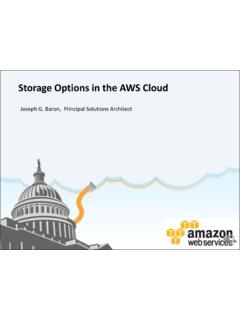Transcription of Software- as- a- Service (SaaS) on AWS
1 saas on AWS September 2010 1 software - as- a- Service ( saas ) on AWS Business and Architecture Overview saas and AWS Introduction software - as- a Service ( saas ) is an application delivery model that enables users to utilize a software solution over the Internet. saas revenue models are typically subscription based, where users pay a fixed recurring fee over a period of time (often monthly or annually). saas providers are drawn to Amazon Web services (AWS) as an ideal infrastructure platform for their saas business as the AWS usage based pricing model and scale on demand infrastructure aligns well with their revenue and operating models. This whitepaper explores the business and technical considerations of deploying a saas offering on AWS versus a co-location or traditional hosting environment. Business Considerations saas offerings present a number of unique challenges when compared to traditional software product models. Specifically, providers must take into account the following: Managing Cash Flow Subscription pricing models, in contrast to perpetual licensing models, don t have large, one time, upfront license revenue coming in as customers on-board.
2 Instead, customers pay smaller, recurring fees over the lifetime of the contract. When choosing a hosting platform, this is an important difference to keep in mind. Traditional hosting environments require large initial capital outlays to procure required infrastructure before a single customer can be on-boarded. Forecasting demand well ahead of actual usage becomes necessary, which in turn exposes two distinct business risks: If the business performs better than expected, there may not be enough servers on hand to support new paying customers. On the other hand, if demand is over-forecasted, you will have low asset utilization, high fixed operating expenses, and ultimately increase the required time duration to recognize positive cash flow for a given customer (see figure below). AWS enables providers to avoid the expense of owning servers or operating data centers. Our Service enables saas providers to add and remove resources as needed based on the real -time demands of their business.
3 This significantly decreases forecasting risk, and improves cash flow positions by only paying for resources when they are actually needed. AWS services can be consumed without minimum usage contracts or long-term commitments, helping providers retain maximum business flexibility. saas on AWS September 2010 2 While there is a transition required from the traditional perpetual license business model, ISVs and shareholders find a recurring subscription model to be favorable on the balance sheet as it builds a more predictable, deferred revenue stream. In difficult economic times, net new license revenue tends to be the first to go. Reduce Platform Support A saas delivery model allows an ISV to dedicate their valuable engineering resources to develop technology that leads to greater innovation and differentiation of their solution in the market. With the distributed client server computing model, the end user takes on the responsibility of building the platform required to support the business application.
4 As such, there are an infinite number of configurations that an ISV must certify to in order to support their customers. Some call this the Matrix of Pain. Consider an ISV who has 10 products, that needs support on 10 different platform configurations ( Windows 2003 running SQL Server on 32-bit, Windows 2008 running SQL on 64-bit, RHEL 4 running Oracle on OVM, RHEL 5 running MySQL on VMWare, ). Each time an update is made to one of the ISV products it mustbe tested against all 10 certified platforms. One update for all 10 software products is equal to100 different variations that need to be tested against and supported indefinitely. saas delivery allows an ISV to free themselves of the Matrix of Pain. Instead of spending tens of millions of dollars on sustaining engineering and legacy support, saas allows an ISV to focus on one platform of their choosing. Increase Sales Velocity and Customer Satisfaction TheInternet has introduced a number of conveniences in our personal and professional lives.
5 One of the most noticeable is a reduction in time to value. Whether it is accessing movies, music, shopping for cars, or downloading a book, the internet has revolutionized customers expectations around instant gratification. Like cloud computing, saas allows an ISV to provide this level of instant gratification to their customer, as well as their sales team and channel partners. No longer does an enterprise sales executive have to wait 4 weeks for a customer to acquire hardware, operating system licenses and data center space followed by installation and configuration of the business application to start an evaluation. The reality is that cloud computing allows ISVs to deliver software in a truly on demand manner. Reduce sales cycles from months to days. Reduce time to value for the customer from months to hours. Win/win. saas allows the ISV to control the software upgrade cycle for the customer. In many cases, end users are reluctant to migrate to newer versions of software simply due to the hassle and uncertainty associated with doing upgrades.
6 This impacts the ISV equally. Customers who don t upgrade need support on legacy platforms. With saas the customer is abstracted from the software installation, configuration, backup, and upgrade process. Therefore, the ISV can continuously upgrade the software to the latest and greatest. Meaning, the end user is always using the newest, most feature-rich, most secure and fastest version of the software . The ISV benefits from seamlessly moving customers along the upgrade path, thus improving customer satisfaction and reducing legacy support costs. Leverage Existing software and Architecture AWS is unique in our approach to true utility based Infrastructure as a Service . Since AWS provides discrete building blocks of low level computing infrastructure, ISVs can leverage existing software and architecture and simply move it to AWS with little to no re-engineering or re-architecting. This is a critical point to note. In order for a saas provider to benefit from the financial advantages of a saas model, they must be able to achieve the greatest return on infrastructure assets.
7 This requires running systems at the highest level of utilization possible. An ISV cannot afford to have dedicated hardware for each customer and run those systems at 20% utilization. The choices are to re-architect, in many cases rewrite software from scratch, which is very costly. Or, write new software to leverage Platform as a Service saas on AWS September 2010 3 offerings. Or, leverage AWS to achieve the economic benefits of multi-tenancy without having to re-write their existing software . As mentioned above, AWS allows the ISV to easily spin up unique environments for each new customer and pay for that infrastructure only when they need it. Managing Uptime for a Global Customer Base A highly reliable and available IT infrastructure requires saas providers to not only maintain reliable storage and backup devices, but also operate a reliable network with redundant networking devices, transit connections, and physical connections between data centers.
8 In addition to backup and reliable networking, saas providers must also have a tested, working solution for disaster recovery. This includes deploying data and applications across multiple data centers either with failure resilient software or in a more traditional hot/cold standby approach. To achieve realistic disaster recovery, all of the data centers and servers involved have to be constantly utilized; if they sit idle, it s almost certain they won t function as desired when activated from a cold start. saas providers need to account for both the cost and the complexity of this redundancy when evaluating their deployment. AWS includes all this in its simple usage charges, and lets customers easily do things like deploy servers in any one of our global regions (East Coast US, West Coast US, EU, and Singapore). Within a region, ISVs can further enable the availability of their application by deploying servers across multiple Availability Zones, which provides the ability to remain resilient in the face of most failure modes including natural disasters or system failures.
9 Providing a Secure Environment Another direct cost for saas providers running their applications is ensuring the confidentiality, integrity, and availability of business critical data. Examples of security costs for saas providers include capital expenditures for network security devices, security software licenses, staffing of an information security organization, costs associated with information security regulatory compliance, physical security requirements, smart cards for access control, and so on. To provide end-to-end security and end-to-end privacy in the cloud, AWS builds services in accordance with security best practices and features, and clearly documents how developers can effectively use those features. AWS customers thus take advantage of Amazon s reliable and secure global computing infrastructure, which has been the backbone of s multi-billion dollar retail business for more than 15 years, at no additional cost to the customer.
10 For more information on AWS security, consult the Amazon Web services : Overview of Security Processes whitepaper at Overall Cost AWS passes on to providers the financial benefits of operating at Amazon s scale. In addition to server, power, and network infrastructure costs, personnel costs also need to be accounted for. These include cost of the sizable IT infrastructure teams that are needed to handle the heavy lifting managing heterogeneous hardware and the related supply chain, staying up-to-date on data center design, negotiating contracts, dealing with legacy software , operating data centers, moving facilities, scaling and managing physical growth, etc. all the things that AWS s services handle on behalf of saas providers. saas Architecture on AWS saas architectures are often variations of the classic three-tier web application hosting model. Design priorities are typically reliability, security, availability, performance, and cost.






